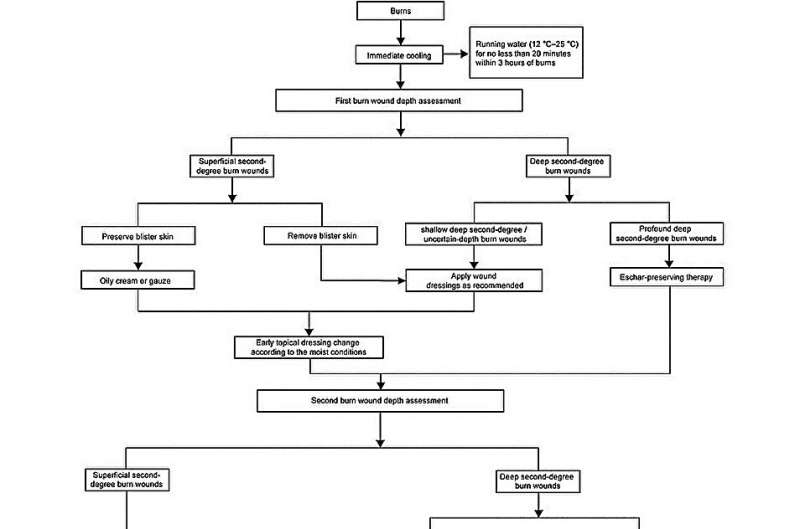This article has been reviewed according to Science X's editorial process and policies. Editors have highlighted the following attributes while ensuring the content's credibility:
fact-checked
proofread
Improving burn treatment: Global consensus on second-degree wound care

In a significant development for medical professionals, a new consensus has been developed to enhance the treatment of second-degree burn wounds. This guideline offers a thorough and systematic method for addressing these frequently occurring injuries, advocating for a standardized approach to care.
The consensus introduces refined methodologies for classifying burn severity and suggests tailored treatment strategies, marking a progressive step forward in burn care.
Second-degree burns are among the most challenging injuries to manage due to their varying depths and healing potentials. Traditionally, the lack of standardized treatment protocols has led to inconsistent patient outcomes. Factors such as burn site, patient age, and burn extent further complicate treatment decisions.
Addressing these challenges required a unified, evidence-based approach to manage these wounds effectively. Thus, an in-depth study and consensus were developed to tackle these critical issues in burn care.
Researchers from the Chinese Burn Association and Cross-Straits Medicine Exchange Association of China published the "Consensus on the treatment of second-degree burn wounds (2024 edition)" in Burns & Trauma on January 30, 2024. This guideline provides standardized recommendations for managing second-degree burns.
The comprehensive document, backed by extensive expert opinions and evidence-based research, addresses various treatment aspects, including prehospital care, nonsurgical and surgical interventions, and infection management.
The consensus introduces a pioneering approach by classifying second-degree burns into superficial, shallow deep, and profound deep categories, enabling more precise treatment strategies. For prehospital first aid, it emphasizes immediate removal from the heat source and adequate cooling to prevent further damage.
Noncontact diagnostic techniques, like laser Doppler imaging, are recommended to assess burn depth accurately. Nonsurgical treatments include using low-toxicity disinfectants and maintaining a moist wound environment. The consensus highlights biological dressings, such as allogeneic skin and amniotic membranes, for their protective and healing properties.
For deep second-degree burns, enzymatic debridement with agents like collagenase and bromelain is advised to preserve viable tissue. Additionally, the guideline sets criteria for diagnosing and grading burn wound infections, ensuring timely interventions. By adopting these practices, the consensus aims to reduce complications and enhance recovery for burn patients.
Dr. Shizhao Ji, a leading researcher in burn treatment, stated, "The 2024 Consensus represents a significant advancement in burn care. By standardizing treatment protocols and incorporating evidence-based practices, we can ensure more consistent and improved outcomes for patients with second-degree burns. This guideline will serve as a vital tool for clinicians worldwide, enhancing the quality of care and recovery for burn victims."
The implementation of these guidelines will revolutionize burn treatment with clear, evidence-based recommendations. This standardization will improve patient outcomes, facilitate consistent data collection and research, reduce health care costs, and enhance the quality of life for burn patients. Future updates will continue to refine and enhance burn care practices globally.
More information: Shizhao Ji et al, Consensus on the treatment of second-degree burn wounds (2024 edition), Burns & Trauma (2024). DOI: 10.1093/burnst/tkad061


















